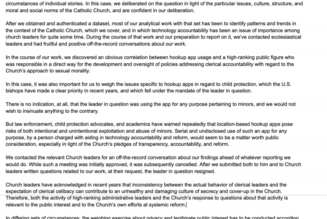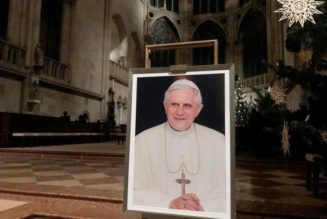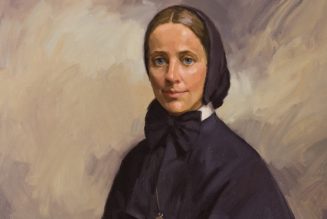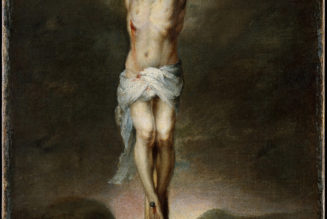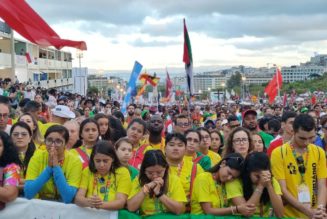
In an unusual act, Pope Francis has included 21 non-Catholic Christians in the Roman Martyrology — an official list of martyrs, saints and blesseds.
What’s more, he did so with the consent of a non-Catholic religious leader.
The non-Catholic Christians were 21 men who had previously been canonized in the Coptic Church (20 of them had been Egyptian and one Ghanian), and the religious leader was the Coptic pope — His Holiness Tawadros II.
While this act was unusual, it was not without precedent. In fact, one can arrive at sainthood — or its close equivalents — through a number of routes.
How We Got Canonization
In the Bible and the early Church, certain people had a reputation for holiness. As a result, Christians would refer to them as “Holy Peter” or “Holy Paul.”
Only with Latin becoming the dominant language in the West, they would say Sanctus Petrus and Sanctus Paulus. With the emergence of vernacular languages like English, those would then become “Saint Peter” and “Saint Paul.”
That’s how we got the title “saint,” and this was originally a purely informal process — just a matter of custom based on an individual’s reputation for holiness.
But people can have different opinions about just how holy someone was, and when Christians gathered for worship, it led to questions about which people could be honored as saints in their common liturgical prayer.
The obvious person to settle these questions would be the local bishop, and initially, bishops made the call about who would be honored as a saint in their diocese. This is sometimes called “local canonization.”
But travel and communication meant that other dioceses would need to work out whether they would also honor a person as a saint, and disagreements occurred. To settle these disagreements, people would appeal to Rome, and eventually, the pope would begin canonizing saints from outside his own diocese.
The first was St. Udalric, a bishop of Augsburg, Germany who was canonized by Pope John XV in A.D. 993. But the pope didn’t become the exclusive canonizer of saints for some time.
The last canonization by someone other than the pope was in A.D. 1153, when the archbishop of Rouen, France — Hugh de Boves — canonized the French Benedictine St. Walter of Pontoise.
The popes also ended up asserting control of the process of beatification — which precedes canonization as a saint and authorizes local veneration of the person, making it a kind of equivalent to “local canonization.”
However, the fact that popes did not assume control of canonization and beatification until the second millennium means that many people listed as saints got the title during the first millennium, when canonization was still a folk process or was under the control of local bishops.
Thus the fact that someone is a saint doesn’t mean that he was canonized by a pope. Many individuals experienced a route to sainthood other than the one we typically think of.
How Canonization (Normally) Works
Even today, there is a role for the local bishop. After a cause for canonization has been opened, the local bishop oversees an investigation of the person, who is given the title “Servant of God.”
Following the successful conclusion of this investigation, its results are forwarded to Rome to the Dicastery for the Causes of Saints.
They investigate whether the individual displayed heroic virtue during his lifetime, and if they find that he did, the pope may authorize the use of the title “Venerable” for the person.
If the individual was a martyr, the pope may then authorize the person to be declared a “blessed.” However, if the individual was not a martyr, a verifiable miracle needs to be linked to his intercession. If such a miracle is found, the pope may authorize him to be declared blessed. This results in permission for local veneration of the person (e.g., in the diocese where he lived) but not full, universal veneration, making it an equivalent of the old-fashioned “local canonization.”
Finally, if — after being declared blessed — a verifiable miracle is again linked to the person’s intercession (or for a first time in the case of a martyr), then the pope may canonize him as a saint.
Normally, this process takes years — even decades or centuries — and involves an enormous amount of research, discussion and paperwork.
Equivalent Canonization
However, the process used by the Dicastery for the Doctrine of the Faith is not a requirement of divine law, as illustrated by the fact canonizations used to be done without it.
Consequently, the pope can intervene in the process and make an exception to the normal formalities of the process.
When this happens, it is referred to as an “equivalent canonization.” It also is called an “equipollent canonization.”
The term equipollent means “of equivalent value,” and the basic idea is that there are other ways of getting the kind of evidence the dicastery normally produces through its formal process.
As it’s commonly explained, the pope basically poses three questions:
- Does the person have a longstanding veneration?
- Does the person have a general reputation for holiness — as illustrated by martyrdom or the heroic exercise of virtue — that still holds up?
- Does the person have a reputation for miracles connected with his intercession?
If the answer to these questions is yes, the pope may decide to skip having the dicastery do further, formal investigations and may canonize the person as a saint.
Recently, this process has attracted attention, as popes have used it several times, but equivalent canonization is not new.
For example, St. Romuald — the 10th-century founder of the Camaldolese order — was canonized by Pope Clement VIII in 1595 using this method.
There have also been some very popular saints as a result of equivalent canonization, including Sts. Norbert, Bruno, Peter Damian, Cyril and Methodius, Cyril of Alexandria, Cyril of Jerusalem, Justin Martyr, John of Damascus, the Venerable Bede, Ephrem the Syrian, Albert the Great, John Fisher and Thomas More.
Each of these individuals also had a route to sainthood other than the one we normally envision.
Non-Catholic Saints?
Even more unusual routes have been taken by people who were not Catholic at the time of their death.
This is understandable, because saints are held up as examples, and the Catholic Church isn’t generally in the business of holding up non-Catholics as exemplars for the faithful.
Another reason is that various Church declarations gave reason to doubt the salvation of non-Catholics. Thus Pope Boniface VIII’s 1302 bull Unam Sanctam said that one needed to be “subject to the Roman Pontiff” for salvation. Non-Catholics weren’t subjects of the Roman pontiff, so it would seem that they shouldn’t be saved and thus shouldn’t be saints.
However, as Catholic thinkers reflected on such statements, they realized that they presupposed something: bad faith. It wasn’t the mere fact of being out of union with the pope that warranted damnation — it was refusing submission to the pope when one knew that one should submit. As a result, properly speaking, it was those who were not in union with the pope out of bad faith that were in mortal sin.
But with time, it was realized that not everyone who was out of union with the pope was in bad faith. This was first discussed among theologians, but eventually, it was endorsed by Church authorities, including popes.
Thus in 1854 — on the day after he defined the Immaculate Conception — Pope Bl. Pius IX gave a speech in which he acknowledged that “it is necessary to hold for certain that they who labor in ignorance of the true religion, if this ignorance is invincible, are not stained by any guilt in this matter in the eyes of God” (D 1647).
Further magisterial documents continued to acknowledge the possibility of salvation for those who were not formally Catholic during their lives, and the Second Vatican Council held that:
Those also can attain to salvation who through no fault of their own do not know the gospel of Christ or his Church, yet sincerely seek God and moved by grace strive by their deeds to do His will as it is known to them through the dictates of conscience. Nor does divine Providence deny the helps necessary for salvation to those who, without blame on their part, have not yet arrived at an explicit knowledge of God and with His grace strive to live a good life (Lumen Gentium 16).
This meant that there would be saints — people in heaven — who had not been Catholic during their lifetimes. But would any of these be given recognition as saints by the Catholic Church?
Early Non-Catholic Saints
The question seems to have been forced by the cause of Christian unity. Following the fragmenting of Christendom into multiple different communions, there have been efforts at reunion — some of them more successful than others.
This is reflected in the history of most of the Eastern Catholic churches. Most of them were for a time out of full communion with the Holy See, and later communion was restored.
But this posed practical questions. Time had not stood still in these churches, and they had recognized the sainthood of various individuals who had lived during the period in which communion was lacking. What should be done about these saints?
One option would have been for the popes to require — as a condition for reunion — that the Eastern churches renounce devotion to these saints and affirm that they are all in hell.
However, this was not the path that the popes chose. It was decided that — just as the difference in liturgical rites did not need to divide us — neither did the veneration of these individuals as saints, and so the popes allowed them to continue to be recognized as heavenly benefactors.
This meant that they would have lived in good faith and were not held at fault by God for their separation from the Catholic Church. Thus, even before Pius IX’s explicit 1854 affirmation, the popes were showing a practical awareness of the possibility of salvation for those not in full communion with the Church.
Thus in the Byzantine Catholic rite, individuals such as St. Photius (810-893) and St. Gregory Palamas (1296-1359) are honored. What is remarkable about these two individuals is that they were sharp critics of the Western Church, and Photius was even involved in a schism, though he did die in communion with the pope.
Various Eastern individuals also have been added to the Roman Martyrology, which is used in the Latin Church, and in 2015, St. Gregory of Narek — a 10th-century Armenian theologian who died outside the Catholic communion — was declared a doctor of the Church.
These individuals also had unusual paths to sainthood.
The 21 Martyrs
A tragic event also occurred in 2015, when members of the terrorist group ISIS beheaded 21 Christians in Libya. Gruesome footage of the beheadings went viral.
Twenty of the executed men were migrant workers from Egypt who belonged to the Coptic Church. The 21st man — Matthew Ayariga — was from Ghana and does not appear to have been a Copt. But when questioned by the Islamic terrorists, he declared, “Their God is my God.”
Days afterward, they were canonized by the head of the Coptic Church — Pope Tawadros II. (The title pope originally meant “father” and was applied to a variety of churchmen; it is still applied to the bishop of Rome and the patriarch of Alexandria.)
This brings us to the 2023 meeting between Pope Tawadros and Pope Francis. During the meeting, Pope Francis stated:
I am glad to announce today that, with the consent of Your Holiness, these 21 martyrs will be inserted into the Roman Martyrology as a sign of the spiritual communion uniting our two Churches. … May the prayer of the Coptic martyrs, united with that of the Theotokos, continue to grow the friendship between our Churches, until the blessed day when we can celebrate together at the same altar and commune in the same Body and Blood of the Savior, ‘that the world may believe.’
The act was thus performed as part of a modern reunification effort, just like the ones of the past, only with a recognition of the common Christian witness of martyrs coming before full reunion.
This is in keeping with calls from Pope St. John Paul II to establish some kind of “common martyrology” among the churches.
In the context of a reunion effort, it only makes sense that Pope Francis would seek Pope Tawadros’ consent. While he could, on his own authority, simply add the 21 martyrs to the Roman Martyrology, it could be perceived as a snub of Coptic authorities if he did so.
Saying, “We really appreciate what the martyrs did and would like to honor them, too, is that okay with you?” sends a much better message for facilitating reunion.
Martyrs or Saints?
How will the 21 martyrs be viewed in the Catholic Church? Into what category will they be put?
Not everybody in the Roman Martyrology is a saint. It also includes blesseds, and some individuals are simply listed as martyrs or in other ways. For example, an older edition of the Roman Martyrology (c. 1900) for Jan. 28 includes:
In Thebais, the holy martyrs Leonides and his companions, who obtained the palm of martyrdom in the time of Diocletian.
In the monastery of Rheims, the demise of a holy priest named John, a man of God.
In Palestine, St. James, a hermit, who hid himself a long time in a sepulcher to do penance for a fault he had committed, and being celebrated for miracles, departed for heaven.
And elsewhere in divers places, many other holy martyrs, confessors, and holy virgins.
None of these individuals is formally called a “saint,” though the adjective “holy” (Latin, sanctus) is used for many of them.
This raises the possibility that the 21 Coptic martyrs might be listed in the Roman Martyrology merely as martyrs rather than as saints. However, it has also been reported:
The French news agency I.Media cited an unnamed Vatican source who said that the 21 would be recognized as saints by the Catholic Church. The source said this was ‘only possible because these baptized persons are already recognized as saints by the Coptic Church.’
Whether the 21 martyrs will ultimately be honored as saints or merely as martyrs remains to be seen.
However, even if they are not given the full title “Saint,” they will have traveled an unusual path to one of sainthood’s near equivalents — being listed in the Roman Martyrology.

